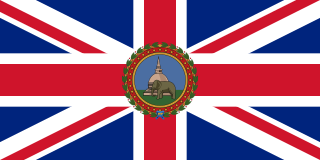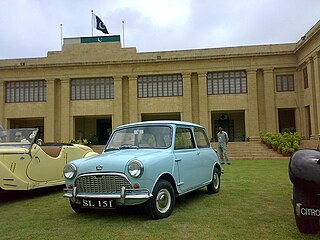
The first written records of the region come from Arab traders in the 9th and 10th centuries. In medieval times, the region was dominated by the Trans-Saharan trade and was ruled by the Mali Empire. In the 16th century, the region came to be ruled by the Songhai Empire. The first Europeans to visit the Gambia River were the Portuguese in the 15th century, in 1447, who attempted to settle on the river banks, but no settlement of significant size was established. Descendants of the Portuguese settlers remained until the 18th century. In the late 16th century, English merchants attempted to begin a trade with the Gambia, reporting that it was "a river of secret trade and riches concealed by the Portuguese."
Government House is the name of many of the official residences of governors-general, governors and lieutenant-governors in the Commonwealth and British Overseas Territories. The name is also used in some other countries.

The governor-general of India was the representative of the monarch of the United Kingdom in their capacity as the emperor/empress of India and after Indian independence in 1947, the representative of the monarch of India. The office was created in 1773, with the title of governor-general of the Presidency of Fort William. The officer had direct control only over his presidency but supervised other East India Company officials in India. Complete authority over all of British territory in the Indian subcontinent was granted in 1833, and the official came to be known as the governor-general of India.

The Parliament of the Democratic Socialist Republic of Sri Lanka is the supreme legislative body of Sri Lanka. It alone possesses legislative supremacy and thereby ultimate power over all other political bodies in the island. It is modeled after the British Parliament. The 16th Parliament of Sri Lanka was dissolved on 24 September 2024.
An official residence is a residence designated by an authority and assigned to an official, and may be the same place where the office holder conducts their work functions or lives.

Bakau is a town on the Atlantic coast of Gambia, west of Gambia's capital city of Banjul. It is known for its botanical gardens, its crocodile pool Bakau Kachikally and for the beaches at Cape Point. Bakau is the first major suburb outside Banjul and the most developed town in the Gambia. Close to Bakau and Banjul is Gambia's largest city, Serekunda.
A Government House is any residence used by governors-general, governors and lieutenant-governors in the Commonwealth and the British Empire. Government Houses serve as the venue for governors' official business, as well as the many receptions and functions hosted by the occupant. Sometimes, the term Government House is used as a metonym for the governor or his office.

The finest colonial structure in Belize City, Government House is said to have been built to plans by the illustrious British architect Sir Christopher Wren with a combination of Caribbean vernacular and English urban architecture.
State House located in Georgetown, is the official residence of the president of Guyana. It was previously the official residence of the governor of British Guiana before the colony gained independence and became Guyana.

The State House, located in Roseau, is the official residence of the president of Dominica. Previously it was used as the official residence of the colonial governors of Dominica.

State House is the official residence of the president of Kenya. It was the prime minister's residence from independence until 12 December 1964 when Kenya became a republic. As the prime minister's position was abolished, it has been the official residence of the president ever since.

The governor of Ceylon was the representative in Ceylon of the British Crown from 1795 to 1948. In this capacity, the governor was president of the Executive Council and Commander-in-Chief of the British Forces in Ceylon. The governor was the head of the British colonial administration in Ceylon, reporting to the Colonial Office.
President's House is the official residence and workplace of the President of Sri Lanka, located at Janadhipathi Mawatha, Colombo, Sri Lanka. Since 1804 it had been the residence of British Governors and Governors-General and was known as the "King's House" or the "Queen's House" until Sri Lanka became a republic in 1972.

Gambian–American relations are bilateral relations between the Republic of The Gambia and the United States of America.

The Governor's House, officially known as Sindh Governor House, and also known by its former names including Government House, Governor-General's House and President's House, is a palace in Karachi, Sindh, Pakistan. It is the official residence of the governor of Sindh. The current governor of Sindh is Kamran Tessori. It is located along the Aiwan-e-Sadar Road of Karachi.

Between 1965 and 1970, the Gambia was an independent sovereign state that shared its head of state with the United Kingdom and other states headed by Queen Elizabeth II. It was a predecessor to the modern-day republic of The Gambia.

The State House is the official residence of the president of Sierra Leone. It is home to the offices of the president, senior presidential staff and associated aides. The State House is located at State Avenue, Tower Hill, in central Freetown.

The State House is the official residence and office of the president of Barbados. It was built in 1702 during the colonial days and served as a Quaker Plantation, until it was purchased by the imperial government, to act as a replacement to the Bagatelle Great House in the Parish of St Thomas.

The Gambia Colony and Protectorate was the British colonial administration of The Gambia from 1821 to 1965, part of the British Empire in the New Imperialism era. The colony was the immediate area surrounding Bathurst, and the protectorate was the inland territory situated around the Gambia River, which was declared in 1894.














